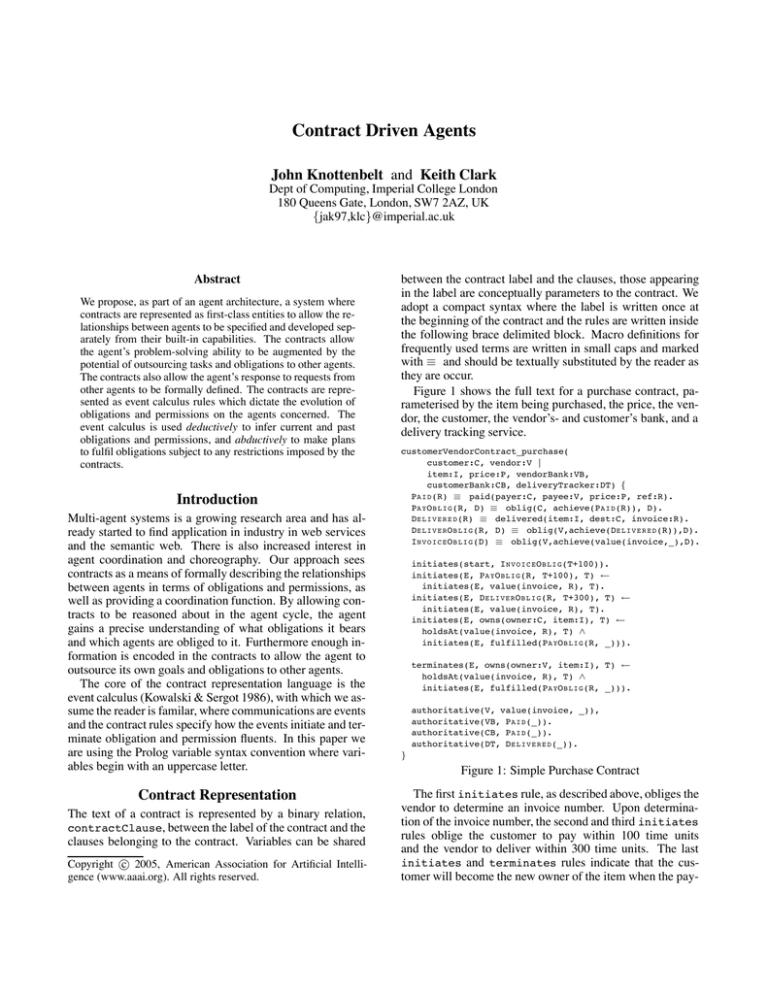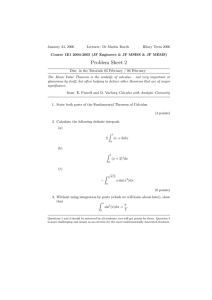
Contract Driven Agents
John Knottenbelt and Keith Clark
Dept of Computing, Imperial College London
180 Queens Gate, London, SW7 2AZ, UK
{jak97,klc}@imperial.ac.uk
Abstract
We propose, as part of an agent architecture, a system where
contracts are represented as first-class entities to allow the relationships between agents to be specified and developed separately from their built-in capabilities. The contracts allow
the agent’s problem-solving ability to be augmented by the
potential of outsourcing tasks and obligations to other agents.
The contracts also allow the agent’s response to requests from
other agents to be formally defined. The contracts are represented as event calculus rules which dictate the evolution of
obligations and permissions on the agents concerned. The
event calculus is used deductively to infer current and past
obligations and permissions, and abductively to make plans
to fulfil obligations subject to any restrictions imposed by the
contracts.
Introduction
Multi-agent systems is a growing research area and has already started to find application in industry in web services
and the semantic web. There is also increased interest in
agent coordination and choreography. Our approach sees
contracts as a means of formally describing the relationships
between agents in terms of obligations and permissions, as
well as providing a coordination function. By allowing contracts to be reasoned about in the agent cycle, the agent
gains a precise understanding of what obligations it bears
and which agents are obliged to it. Furthermore enough information is encoded in the contracts to allow the agent to
outsource its own goals and obligations to other agents.
The core of the contract representation language is the
event calculus (Kowalski & Sergot 1986), with which we assume the reader is familar, where communications are events
and the contract rules specify how the events initiate and terminate obligation and permission fluents. In this paper we
are using the Prolog variable syntax convention where variables begin with an uppercase letter.
Contract Representation
The text of a contract is represented by a binary relation,
contractClause, between the label of the contract and the
clauses belonging to the contract. Variables can be shared
c 2005, American Association for Artificial IntelliCopyright gence (www.aaai.org). All rights reserved.
between the contract label and the clauses, those appearing
in the label are conceptually parameters to the contract. We
adopt a compact syntax where the label is written once at
the beginning of the contract and the rules are written inside
the following brace delimited block. Macro definitions for
frequently used terms are written in small caps and marked
with ≡ and should be textually substituted by the reader as
they are occur.
Figure 1 shows the full text for a purchase contract, parameterised by the item being purchased, the price, the vendor, the customer, the vendor’s- and customer’s bank, and a
delivery tracking service.
customerVendorContract_purchase(
customer:C, vendor:V |
item:I, price:P, vendorBank:VB,
customerBank:CB, deliveryTracker:DT) {
P A I D (R) ≡ paid(payer:C, payee:V, price:P, ref:R).
P A Y O B L I G (R, D) ≡ oblig(C, achieve(P A I D (R)), D).
D E L I V E R E D (R) ≡ delivered(item:I, dest:C, invoice:R).
D E L I V E R O B L I G (R, D) ≡ oblig(V,achieve(D E L I V E R E D (R)),D).
I N V O I C E O B L I G (D) ≡ oblig(V,achieve(value(invoice,_),D).
initiates(start, I N V O I C E O B L I G (T+100)).
initiates(E, P A Y O B L I G (R, T+100), T) ←
initiates(E, value(invoice, R), T).
initiates(E, D E L I V E R O B L I G (R, T+300), T) ←
initiates(E, value(invoice, R), T).
initiates(E, owns(owner:C, item:I), T) ←
holdsAt(value(invoice, R), T) ∧
initiates(E, fulfilled(P A Y O B L I G (R, _))).
terminates(E, owns(owner:V, item:I), T) ←
holdsAt(value(invoice, R), T) ∧
initiates(E, fulfilled(P A Y O B L I G (R, _))).
authoritative(V, value(invoice, _)),
authoritative(VB, P A I D (_)).
authoritative(CB, P A I D (_)).
authoritative(DT, D E L I V E R E D (_)).
}
Figure 1: Simple Purchase Contract
The first initiates rule, as described above, obliges the
vendor to determine an invoice number. Upon determination of the invoice number, the second and third initiates
rules oblige the customer to pay within 100 time units
and the vendor to deliver within 300 time units. The last
initiates and terminates rules indicate that the customer will become the new owner of the item when the pay-
ment obligation has been fulfilled.
The authoritative clauses indicate which agents are
authoritative for which fluents. In the example, only the vendor is able to determine the invoice number by sending an
inform message to the customer. This mechanism also identifies trusted-third parties: the banks are authoritative for the
paid fluents (that is any payment from customer to vendor)
and the delivery tracker agent is authoritative for the proof
of delivery fluent.
The agent maintains a record of all the sent and received
events, which are accessible in the happens predicate (see
below). We require that the events relevant to a contract are
observed by all contract principals because the state of the
contract depends on the history of events relevant to it. In
a two party contract, this requirement is trivially satisfied
when one principal sends a message to another.
We abstract away from the details of message format and
transport through a set of predicates on the messages. These
predicates are used in the contract language and agent code
either as tests on received messages, or as constraints on
messages about to be sent (this occurs when an agent is
obliged to do a communication subject to some specified
constraints). (Knottenbelt & Clark 2004)
Contract Execution and Planning
Since an agent may have many contracts active at the same
time, it is important to be able to consider the contracts
both independently of each other (for example to determine a contract’s state), and also in combination (for example when outsourcing goals). For this reason we define a meta-interpreter predicate, selon, which evaluates
queries relative to a specified contract. The first parameter is the contract label, and the second is the formula
to be evaluated. The agent can now query what obligations are current with respect to a contract by asking
selon(C, holdsAt(oblig(A, G, DL), Now)) where
Now is a time point representing the current time and C is
the label of an active contract.
Both the agent rules and contract rules are represented in
the event calculus, so it is possible to create plans to fulfil
obligations using an abductive event calculus planner. Planning is about future events and it is necessary to make some
assumptions about what kinds of events will (or can) occur
in the future. For example, we can plan to perform any actions of our own choosing, but we may only assume that
other agents will do those actions that they are obliged to
do. We encode these assumptions as integrity constraints in
a similar style to (Endriss et al. 2004).
Related Work
In Agent0 (Shoham 1991), agents are programmed by specifying a set of capabilities (commitment rules). Instead of
building the commitment rules directly into the agent, our
architecture allows these rules to be specified in the contract
in the form of event calculus initiates and terminates rules.
(Verharen & Dignum 1997)’s cooperative information
agents are based on the language action perspective. The architecture specifies three main categories of activities: tasks,
transactions and contracts, which are represented as deontic
state machines of transaction transitions. Our work differs
in conceptual break down, as well as in the underlying formalism (being the event calculus). We expect it to be more
reactive and dynamic through the use of both an abductive
planner as well as a plan library.
(Kollingbaum & Norman 2002) describes a system of supervised interaction where agents are supervised by a third
party called an authority. We do not require this infrastructure, although it does admit a logging agent should the particular situation demand it. Furthermore the agents themselves are responsible for enforcing the contractual norms.
The event calculus has been successfully applied in the
representation and monitoring of service level agreements
in the utility computing domain (Farrell et al. 2004).
Conclusion
Contracts are a useful way to program agent behaviour.
When the agent contracts are analogous to real world contracts, they can greatly speed business transactions and lend
flexibility to the manner in which they are executed. Furthermore, specifying the relationships between agents separately
to the agents’ capabilities is not only good software engineering because concerns are separated, but also facilitates
analysis and verification since the contracts are represented
in a formal language, the event calculus.
Event calculus is especially suitable for contract language
representation because the semantics are unambiguous and,
given a reliable log of events, the conclusions derived cannot be disputed. Additionally, abduction over event calculus
logic programs produces partially ordered plans. Integrity
constraints can be used to control the generated plans, and
can be used effectively to encode assumptions about obligation fulfilment and future agent action. By executing the
abductive proof procedure over all the agreed contracts, an
agent may use one contract to solve obligations imposed on
it by another, effectively outsourcing the obligation.
References
Endriss, U.; Mancarella, P.; Sadri, F.; Terreni, G.; and Toni, F. 2004. Abductive logic
programming with ciff: Implementation and applications. In Proceedings of the
Convegno Italiano di Logica Computazionale (CILC-2004). University of Parma.
Farrell, A.; Sergot, M.; Trastour, D.; and Christodoulou, A. 2004. Performance monitoring of service-level agreements for utility computing using the event calculus. In
Proceedings of First IEEE International Workshop on Electronic Contracting, 2004,
17–25. IEEE.
Knottenbelt, J., and Clark, K. 2004. Contract-based communicating agents. In
Proceedings of the Second European Workshop on Multi-Agent Systems.
Kollingbaum, M. J., and Norman, T. J. 2002. Supervised interaction: creating a
web of trust for contracting agents in electronic environments. In Proceedings of the
First International Joint Conference on Autonomous Agents and Multiagent Systems,
272–279. ACM Press.
Kowalski, R. A., and Sergot, M. 1986. A logic-based calculus of events. New
Generation Computing 4(4):319–340.
Shoham, Y. 1991. Agent0: A simple agent language an its interpreter. In Proc. of
AAAI-91, 704–709.
Verharen, E., and Dignum, F. 1997. Cooperative Information Agents and communication. In Kandzia, P., and Klusch, M., eds., Cooperative Information Agents, First
International Workshop, number 1202 in LNAI, 195–209.



